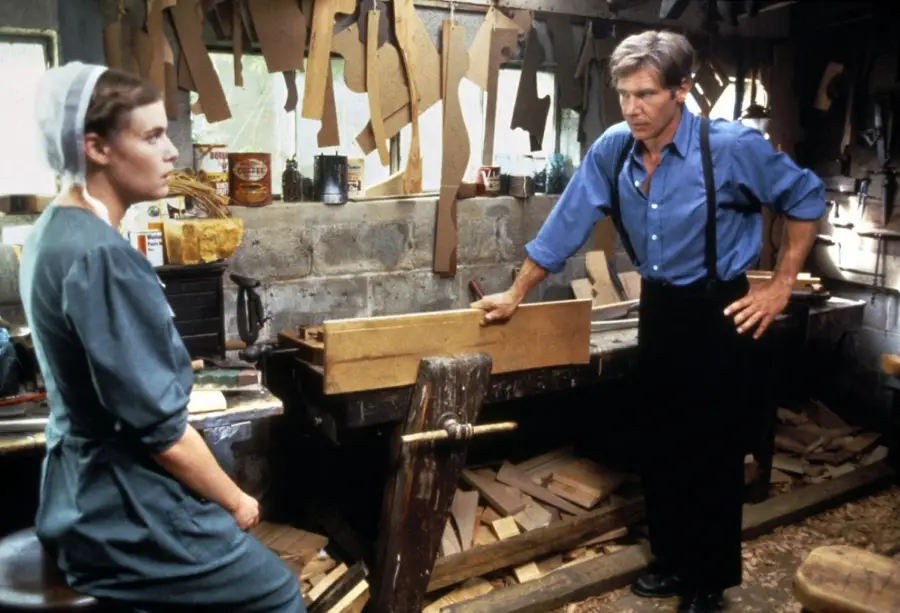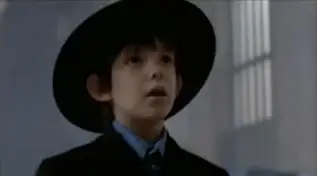
Director: Peter Weir
Producer: Edward S. Feldman (Paramount)
Writers: William Kelley and Earl W. Wallace (story/screenplay), Pamela Wallace (story)
Photography: John Seale
Music: Maurice Jarre
Cast: Harrison Ford, Kelly McGillis, Lukas Haas, Jan Rubes, Josef Sommer, Danny Glover, Angus MacInnes, Alexander Godunov, Brent Jennings, Patti LuPone, Frederick Rolf, Viggo Mortensen
![]()
Introduction
So many Hollywood flicks are based in New York or Los Angeles, that it feels wonderfully refreshing when a film explores an unexplored American setting (i.e. Fargo). With Witness, two one-time-only screenwriters, William Kelley and Earl W. Wallace, wrote such a good script that they not only drew Harrison Ford and Kelly McGillis to Lancaster, Pa., they walked off with Oscars in the end.
This is the true legacy of Witness, as a textbook for budding screenwriters on how to balance atmosphere and action, story and theme, thriller and romance, unraveling plot with complex character development. If you want to learn how to write screenplays, check this one out, ranking No. 80 on the WGA’s Top 101 Screenplays of All Time.
![]()
Plot Summary
Rachel Lapp (Kelly McGillis) is an Amish widow taking her young son Samuel (Lukas Haas) on a trip after the death of her husband. While in a train station bathroom stall, Samuel becomes the sole witness to a murder, perpetrated by Fergie (Angus MacInnes) and McPhee (Danny Glover). The boy and his mother come under the watch of Philly detective John Book (Ford), who allows them to stay with his sister (Patti LuPone). That is until he discovers that young Samuel is not safe with anyone, not even police captain Schaeffer (Josef Sommer).
He takes the boy and his mother back home to Pennsylvania Amish Country, where it will be near impossible for the murderers to trace them. Book must stay in hiding with them at the farm under the watch of wise Amish elder Eli Lapp (Jan Rubes). While recovering from a wound, he shares intimate moments with Rachel, despite her already having an Amish suitor, Hochleitner (Alexander Godunov of Die Hard fame). Is a relationship really possible for this Amish woman and her handsome cop outsider? Or is it not meant to be when the killers arrive, bringing gun violence to their peaceful farm?
![]()
True Romance
The love struggle between cultural opposites makes for one of the real iconic romances in movies — two people who want desperately to make love, but can’t because of the woman’s beliefs. McGillis, who achieved pop culture fame the following year in Top Gun (1986), is fantastic as the caring mother and tortured lover, torn between the traditions of her home and the yearnings of her heart.
As for Ford, it remains the only Oscar nomination for Best Actor in his storied career, despite massive hits like Star Wars (1977), Raiders of the Lost Ark (1981) and Blade Runner (1982). While Ford wooed the ladies as Han Solo and Indiana Jones, he was his most charming in the Witness barn dance scene, twirling McGillis in the headlights of his car, singing with Sam Cooke to the radio:
“Don’t know much about history. Don’t know much biology. Don’t know much about science books. Don’t know much about the French I took. But I do know that I love you. And I know that if you love me too, what a wonderful world this would be.”
To Book, the song was 30 years old, but it was brand new for Rachel, who has been sheltered from the outside world. That scene alone is enough for the No. 82 spot on the AFI’s 100 Passions, but Witness goes a step further, brilliantly developing its romantic subplot throughout.
![]()
Screenplay
Kelly and Wallace were former TV writers on Gunsmoke and the miniseries How the West Was Won (1977). How do first-time film screenwriters win the Oscar for Best Original Screenplay? It’s because they knew exactly what they were doing going in; they understood the craft of screenwriting. Take for instance their need to reveal important exposition about Book’s character flaws. They brilliantly do it through a combination of Book’s spunky sister (characters with attitude are always the best to reveal important info) and the innocence of Rachel, whose naive Amish background allows her to blurt out things without society’s usual filter. From this we get the great scene in the cafe, where Rachel reveals the inner-workings of Book:
RACHEL: “[Your sister] thinks that you ought to get married and have children of your own. Except she thinks you’re afraid of the responsibility. She thinks you like policing because you think you’re right about everything and that you’re the only one who can do anything, and that when you drink a lot of beer, you say things like, ‘None of the other police know a crook from a bag of elbows.'”
Beyond the clever character development, beyond the romantic subplot, beyond even the precision of plot points, Kelley and Wallace are smart enough to couch the entire thing in an atmosphere of culture clash, which adds an entirely deeper layer to the picture. Take for instance the Amish elders’ concern over the possibility of Book dying at their farm. They shouldn’t announce Book’s death because the killers would find Samuel, but they feel they must because their religious faith calls for a proper burial. More fascinating is the Amish concern about Book bringing a handgun into their clean farm country. Note Eli’s speech to Samuel after he finds Book’s handgun:
ELI: “This gun of the hand is for the taking of human life. We believe it is wrong to take life. That is only for God. Many times wars have come and people have said to us, ‘You must fight. You must kill. It is the only way to preserve the good.’ But Samuel, there’s never only one way. … What you take into your hand, you take into your heart. ‘Wherefore, come out from among them and be ye separate,’ saith the Lord, ‘and touch not the unclean thing.'”
No matter your take on guns in society, you must admit the film charts gutsy territory. Rather than tying guns and God together in a blanket statement of “clinging to guns and religion,” Witness argues that guns and God shouldn’t go together.
![]()
Direction
Enter director Peter Weir, who loves playing with this theme of gunplay. During the key turning point at the police station, when Samuel looks at the trophy case, Weir juxtaposes two trophies side-by-side, one topped with a rifle, the other topped with an angel, appearing as if the gun is firing at the angel.

Weir also takes us to an over-the-shoulder shot of an angel statue at the train station, placing the camera up high in the air as if from the perspective of the statue, looking down at young Samuel below, who looks up in wonder. This image of an angel statue placed right in the middle of the high airport technology reminds us of the many traditional religious icons placed amongst our modern world, and suggests a struggle between humanity’s quest for progressive modernity and old-fashioned values.


Weir’s direction not only applies to his culture clash theme, but also to the difficulty of love. Note his symbolic use of a lemonade glass in a moment of love-triangle tension, where Rachel and Hochleitner sit side-by-side on a porch. The camera is placed right next to Hochleitner’s arm, and we see his hand holding a glass of lemonade in the foreground while Book is visible in the background. Surely it’s no coincidence that Hochleitner later offers Book the glass of lemonade during the barn-raising sequence, a gesture that makes it impossible for us to hate Hochleitner, even if we’re rooting for Book. Establishing this makes us even more curious about the final image of the film, when Book and Hochleitner share a few words which we are unable to hear.
Even if much of the credit belongs to the writers, Weir proves his director’s chops, giving a powerful Hollywood debut after starting his career in Australia with films like Gallipoli (1981). After Witness, he would go on to direct two modern classics in Dead Poet’s Society (1989), a blueprint for every teaching movie to follow, and The Truman Show (1998), which predicted the entire reality TV movement. Still, Witness is by far Weir’s most atmospheric, as the unique Amish country setting adds a unique twist every step of hte way. While thousands of films end with a shoot-out, Weir uses the setting to create something fresh, building tension with POV shots up silo shafts and offering cinema’s first “death by grain.”
Thousands more films begin with establishing footage to set the time and place, but few so effortlessly illustrate the core theme like Witness with a horse and buggy struggling to keep ahead of a MAC truck. Perhaps the most memorable image of the entire film is its first, depicting mesmerizing wind moving along the tall grass of Amish country. It’s lyrical, just like the synthesized, Oscar-nominated score by Maurice Jarre, that wonderful composer of Lawrence of Arabia (1962) and Doctor Zhivago (1965).
![]()
Legacy
The film’s atmosphere carved a place for it in our cultural memories. It’s “that Amish movie,” people will say, its reputation linked to its setting like Fargo and the North Dakota snow. Yet despite its critical acclaim — it was nominated for Best Picture — Witness didn’t become a huge cultural phenomenon. It made a modest $68 million at the box office, good for eighth highest that year, but far from the No. 1 grosser that year, Back to the Future (1985), which made $210 million. Today, many young viewers have likely never heard of it, possibly confusing it with the lame Tim Allen-Kirstie Alley comedy For Richer or Poorer (1997). Such lackluster response is reflected in the film’s 7.5 IMDB rating.
This is not all that surprising. The movie ends more ambiguous than some casual viewers would like, because the screenwriters are going for something more profound. Unlike most tidy Hollywood endings, the villain is given shreds of a conscience, while the two lovers must realistically return to their separate worlds. Thus, Witness rises to a higher level of artistry than the usual demise of the evil villain or the unlikely lovers living happily ever after. Weir’s ending rings far truer, and gives viewers something to think about when the credits roll. That’s why Kelley and Wallace were given Oscars. That’s why critics rate it a 91% on Rotten Tomatoes. And that’s why the folks at Entertainment Weekly voted Witness No. 68 on the Best Movies of the Last 25 Years, higher than Unforgiven (1992), Thelma and Louise (1991) and Office Space (1998). In that same list, Witness beat out its 1985 box-office nemesis, Back to the Future, and its 1985 Best Picture nemesis, Out of Africa. Don’t know much about history, but I do know that I love Witness, and I know that if you loved it to, what a wonderful world this would be.
